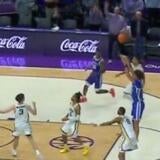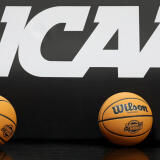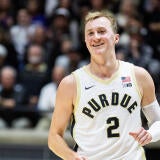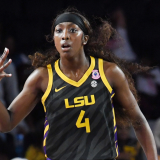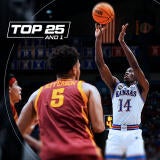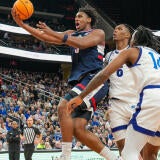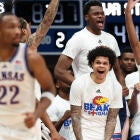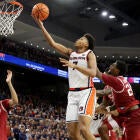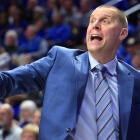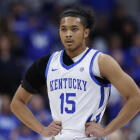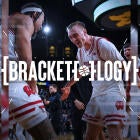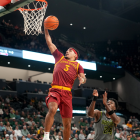College basketball rankings: Rotation questions for the Top 25 and 1 teams
The best teams in America have to sort some things out quickly with the season opener rapidly approaching.
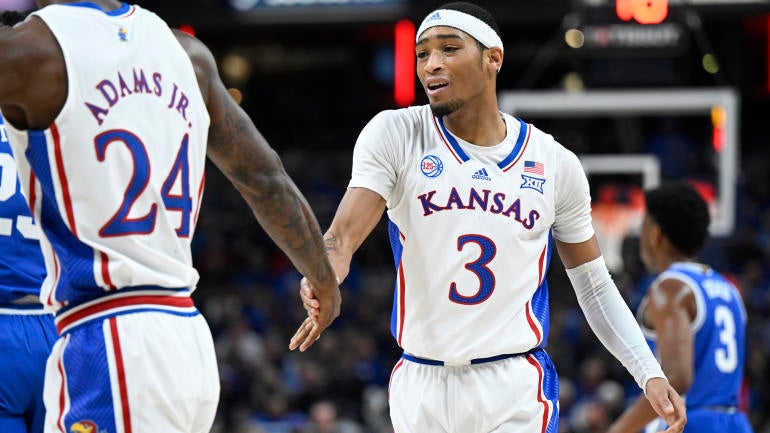
The exhibitions throughout college basketball in mid-to-late October are such a tease. The offseason is long and newsworthy (like, uh, Tony Bennett retiring), but that first sneaker squeak or mean mug can bring hope to anybody and everybody.
Talking Season is almost over. Questions are about to be answered in a real, tangible way. Winter is truly coming.
Let's dive into key rotation questions for each team in CBS Sports' Top 25 and 1 rankings.
1. Kansas
Who is the backup point guard?
As Dajuan Harris' minutes have increased, his efficiency has decreased. He shot a career-worst 47% at the rim last year and his defensive tape was not up to his lofty standards. Kansas coach Bill Self would love not to play Harris around 35 minutes per game like last year, but preseason injuries are already making that easier said than done. Elmarko Jackson (torn patellar tendon) is done for the season and Mississippi State transfer Shakeel Moore had surgery in mid-September to mend a broken foot. He was expected to shoulder a real role, but the timeline for his return to full strength is cloudy.
Northern Illinois transfer David 'Diggy' Coit could be part of the solution, but his lack of defensive bite is scary. South Dakota State transfer Zeke Mayo is more of a scorer/creator than a true initiator point guard. Still, Kansas could lean into more positionless basketball with Mayo, Rylan Griffen and AJ Storr all showing the ability to handle it paired with two big men (KJ Adams and Hunter Dickinson) who can certainly pass.
Those creative lineups could lead to a more refreshed, more impactful Harris.
2. Alabama
Will Nate Oats prioritize a true point guard?
A traditional, set-the-table point guard is a bit overrated these days, but Aaron Estrada helped get Alabama humming with some of his helpful drives and push-ahead passes in transition. Preseason injuries to South Florida transfer Chris Youngblood and five-star freshman Derrion Reid have opened the door for fellow prized freshman Labaron Philon to get more opportunities.
Philon is likely the closest thing to a true point guard on this roster and if he's good enough, he could shift preseason Player of the Year Mark Sears back into that scorer/creator role that he thrived in last season.
3. Houston
Can Houston find enough minutes for Joseph 'JoJo' Tugler?
JoJo Tugler would probably start for 363 of the 364 Division I teams this year. The sophomore forward is a whale of a defender who racks up deflections left and right, but Houston program staple J'Wan Roberts is ahead of him in the pecking order. Roberts, like Tugler, is one of the elite defenders in the sport. Tugler is also likely behind big man Ja'Vier Francis, who ranked fourth in Big 12 play in block percentage and aces his role as the back-line protector for the best defense in college basketball.
Tugler will likely flip-flop between the 4 and the 5, backing up both Francis and Roberts, but do not be surprised if he makes a real run at the starting center spot and doesn't let anyone take it away from him.
4. North Carolina
Who's the third starting guard?
Overreacting to one exhibition game can be fool's gold. Remember when Arkansas beat Purdue last year? That was fun. But the competition for the third guard spot seems over in North Carolina. Junior Seth Trimble dropped a 30-piece on Memphis and looked so comfortable getting into the middle of the floor at will and flying up and down in transition. Five-star freshman Ian Jackson looked a bit out of sorts in his first collegiate action. Such is life for diaper dandies.
Jackson will be a big piece of this UNC squad in the future, but Trimble is the best option to start next to Elliot Cadeau and RJ Davis.
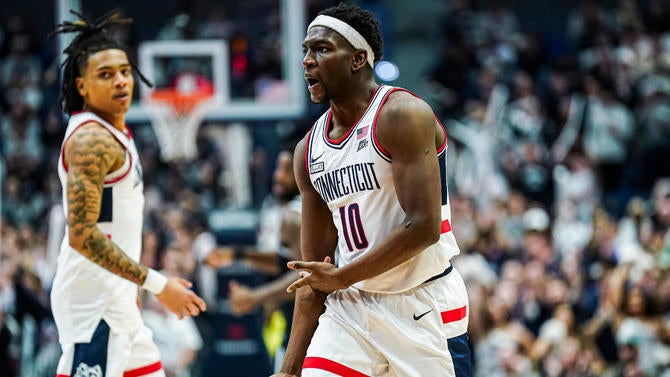
5. UConn
Who's the best option at the 1?
Hassan Diarra is a career backup. He's started just 13 of his 133 career games. That's fixin' to change this season. Diarra is slated to get the nod at point guard, but he'll have to hold off numerous studs for the job. There's a real world where Saint Mary's transfer Aidan Mahaney just has to be on the floor next to much-improved sophomore Solo Ball. Mahaney's positional flexibility -- he played both the 1 and the 2 at Saint Mary's -- makes it feasible.
Mahaney is by far the better shooter, but Diarra is a point-of-attack defender who might be endearingly best described as a cockroach. There's room at the inn for all three of those guards (Diarra, Mahaney and Ball) to split 80 minutes nearly evenly, but it's a battle, nonetheless. Consider it a first-world problem for Dan Hurley and the UConn staff.
6. Iowa State
Let's go big.
Iowa State's positional size can get really interesting, really quickly if coach T.J. Otzelberger rides with Milan Momcilovic, Joshua Jefferson and Dishon Jackson at the same time. That's 6-foot-8, 6-foot-8 and 6-foot-11, respectively. It might get the best out of everybody. Jefferson is one of the best defenders in the country. He can flip-flop between guarding wings or big forwards depending on the matchup. It'd allow Momcilovic to conserve a bit more energy for the heavy load he's expected to carry offensively. Plus, Jackson is just a space-eater inside who is way more skilled than he gets credit for. Iowa State's jumbo lineup is going to be a flat-out handful.
7. Baylor
Can the small-ball lineup work?
There was a little Baylor nugget in Matt Norlander's terrific Top 100 and 1 best teams column that shouldn't get overlooked. Baylor seems determined to try and get its best five players on the floor together, positional size be damned: Jeremy Roach, Jayden Nunn, Langston Love, VJ Edgecombe and Norchad Omier. That's a lineup without a single player taller than 6-foot-7. Baylor's offense has been elite without a five-out center, and now it has one in Omier.
Four awesome guards surrounding an elite, five-out center like Omier? Good luck stopping that. Scott Drew is clearly banking on Baylor's offense being its best defense.
8. Gonzaga
Six players for five spots
Michael Ajayi's lineup versatility unlocks options galore for Mark Few and the Zags' staff. Ajayi can play the 4 with Graham Ike at the 5 without a problem. That would open up a spot for Arkansas transfer Khalif Battle to step into the starting lineup next to Ryan Nembhard and Nolan Hickman. That's an explosive, potent three-headed monster. But Gonzaga could also shift Ajayi to the 3 and insert Ben Gregg at the 4 for some added size and plenty of spot-up shooting. Battle's attention to detail defensively could be the deciding factor.
9. Duke
Who is the winning time 5-man?
Khaman Maluach has one of the highest long-term ceilings on the Duke roster, but Syracuse transfer Maliq Brown could push his way onto the floor during those highly-important closing minutes when every single possession matters. Brown might not be the rim-protector that Maluach, a 7-foot-2 skyscraper, presents, but switchability is everything in late-game scenarios when opposing offensive coordinators are trying to find mismatches to attack.
Brown is just as comfortable guarding on the perimeter as anybody on the roster, and Duke may not sacrifice much rim protection when Cooper Flagg is still on the floor. Maluach is the starter. Brown could very well be the closer.
10. Auburn
Will Auburn embrace the Twin Towers lineup?
There's internal belief in Chaney Johnson being a big part of the "Jaylin Williams Replacement Plan," but Auburn could also adopt some lineups with Johni Broome at the 4 and Dylan Cardwell at the 5. The reasons are pretty clear. It would carve out more minutes for Broome, who had one of the highest net ratings in the country last year. Broome's skill level is off the charts. He can pass, dribble and shoot better than most big men in the country while providing sturdy defense. It also clears the runway for Cardwell to do his thing. The 6-foot-11, 255-pound center is an elite shot-blocker with impeccable timing. He's a real lob threat on the other end, too.
That Broome-Cardwell lineup could certainly be a real tool in Bruce Pearl's bag.
11. Texas A&M
Can CJ Wilcher carve out a major role?
Texas A&M shot just 29.3% from 3-point range last season, ranking 342nd nationally. To fix that, the Aggies targeted Nebraska transfer CJ Wilcher, who drilled nearly 40% of his 3-pointers. Wilcher is an excellent catch-and-shoot sniper, but his ability to come off pindowns and fire on the move makes him such a tougher cover. He's a moving target, so to speak.
But his path to minutes is not clear. Wade Taylor IV, Zhuric Phelps and Manny Obaseki seem like safe bets to start, but Wilcher also has a strong case to be a piece of that starting 5, especially if Phelps can give Texas A&M's second unit more on-ball juice.
12. Purdue
Let's chat about some screens.
Ah yes, everyone's favorite subject. Screening! Well, it's a big deal for a Purdue offense that has to replace Zach Edey, a generational player who also happens to be a once-in-a-lifetime screener. Edey scraped defenders off of Braden Smith, who turned into one of the most potent pick-and-roll scorers in the country last year. Edey's screens, combined with Smith's tireless offseason work, was a big reason for the massive jump in Purdue's ball-screen efficiency.
Who does that this year?
Trey Kaufman-Renn is a well-built, 6-foot-9, 230-pound big man who will start at center, but he's also going to get some run at the 4. That backup big man competition between rising freshman Daniel Jacobsen and redshirt-sophomore Will Berg will be fascinating. Both guys check in at well over 7-foot-2, but sources indicated that Berg's physicality may end up tilting the scales in his favor.
Bulldozing screens will curry plenty of favor with this Purdue staff.
13. Arkansas
How many three-guard lineups will John Calipari utilize?
There's been a lot of hand-wringing over whether Arkansas has a true point guard, but the Hogs' best lineup might just include all three of DJ Wagner, Boogie Fland and Johnell 'Nelly' Davis. Wagner is an excellent defender who should provide plenty of big-guard drives. Fland is so shifty and skilled in the pick-and-roll. Davis is an outstanding scorer both on and off the ball. The progress of wings like Karter Knox, Billy Richmond and Adou Thiero could determine just how much Calipari lets his three guards cook together like he did last year at Kentucky with Reed Sheppard, Rob Dillingham and Antonio Reeves.
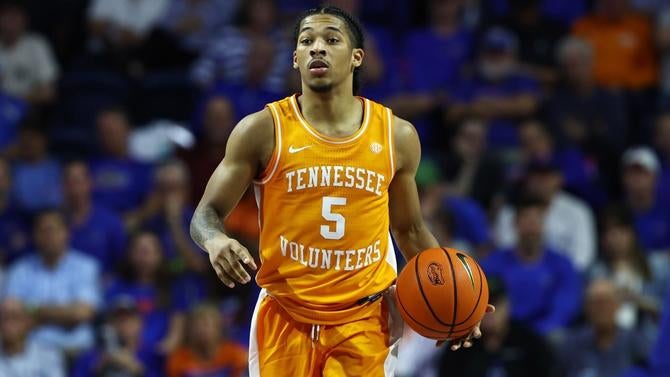
14. Tennessee
Who joins the defensive party?
Zakai Zeigler is one of the elite point-of-attack defenders in the sport. Jahmai Mashack is one of the elite sturdy, versatile perimeter defenders in the sport. Felix Okpara is one of the top shot-blockers in the country. That's three outstanding defenders at three different levels of the floor.
Tennessee is looking for two more guys to join that fray. You don't have to be superstar defenders -- Zeigler, Okpara and Mashack can douse so many fires -- but you better show up. Generating deflections gets you on the floor for Tennessee.
15. Ohio State
Can Devin Royal crack this closing lineup?
Royal is a bit of a forgotten man in Ohio State's new-look frontcourt that features two five-star transfers from blue-blood programs. Royal can be a significant part of this Ohio State club because of his ability to score with his back to the basket. When the game slows down and you have to score in the halfcourt, drawing two defenders to the ball, via a post-up, can be a useful part of an offense. Royal showed glimpses of post-up brilliance down the stretch last season. The 6-foot-6, 210-pound forward is a matchup nightmare with a boatload of quick-twitch moves and grown-man strength in the paint.
If coach Jake Diebler has a matchup he thinks he can exploit, Royal can be the man for the job.
16. Arizona
Anthony Dell'Orso's impact looms large
It might be flying a bit under the radar nationally, but Arizona's perimeter shooting outside of Caleb Love is shaping up to be a major question. Jaden Bradley, KJ Lewis, and Trey Townsend are low-volume, 3-point shooters. That makes Dell'Orso such a big piece of this roster construction. He just has to shoot it at a high level to ease some of the pressure on Love to make 3s to open space for Bradley's drives and Arizona's cavalry of big men.
Dell'Orso, a 6-foot-6 Aussie, drilled just a smidge under 39% of his catch-and-shoot 3-pointers last year at Campbell. His handle is pretty nice, and he's got an under-control, stepback jumper in his bag that makes him a tough cover. If his defense is up to snuff, it's a game-changer.
17. Marquette
So, about that rim defense…
Marquette's rim defense was shockingly different with and without Oso Ighodaro on the floor. With him, Marquette opponents shot just 51% at the rim. Without the current Phoenix Sun big man, opponents shot 68% at the rim. That will not cut it. One solution could be playing Ben Gold at the 4 with Caedin Hamilton, a bouncy, 6-foot-9, 240-pound forward, at the 5.
18. Indiana
Who is on the floor during closing time: Trey Galloway or Kanaan Carlyle?
These are two good backcourt options for Mike Woodson. Galloway is the trustworthy, fifth-year senior who can defend and should shoot it better this year because an improved roster should create easier shots for him. Carlyle is the twitchy, prized Stanford transfer who can create so many advantages with his ability to get into the paint routinely.

19. UCLA
Who earns the last backcourt spot?
UCLA has oodles of depth, so the competition for playing time is going to be fierce. Dylan Andrews and Kobe Johnson seem locked into two of the three starting slots in the backcourt. That third and final one is wide open. Sebastian Mack provides that foul-drawing fiend that Mick Cronin covets. Skyy Clark and Dominick Harris can both shoot it, and that was a major problem for the Bruins last year. Freshman Trent Perry has the skill, shooting and feel that everyone craves. Maybe Cronin tabs the trustworthy veteran shooter, Lazar Stefanovic, and rides with a jumbo lineup. There are options galore. This competition might be fluid all year long.
20. Texas
Who is the alpha?
Texas' lineup is filled with so many guys who were used to taking big shots last year. Tramon Mark did it for Arkansas. Kansas State ran through Arthur Kaluma in plenty of late-game scenarios. Five-star guard Tre Johnson is the real deal. Oregon State transfer Jordan Pope hit some enormous buckets. Figuring out this pecking order is vital if Rodney Terry wants to maximize this group.
21. Creighton
Who is the 4?
Creighton has four different options that could end up starting next to Ryan Kalkbrenner in the Bluejays' frontcourt: Mason Miller, Jackson McAndrew, Isaac Traudt or Jasen Green. They're all a little different. Miller is a low-usage, deadeye shooter and a solid rebounder. Traudt provides a bit more physicality at 6-foot-10 and 235 pounds, but he can shoot it, too. McAndrew is the flashy, new toy. The top-40 prospect is a deadeye sniper who needs to fill out his body but has so much upside. Green isn't much of a shooter yet, but he's a rabid offensive rebounder who brought some junkyard dawg to the lineup.
Who will Greg McDermott ride with?
22. Florida
Which frontcourt duo is in the closing lineup?
Todd Golden built a frontcourt that will come at you in waves. Florida has four different big men who will play: sophomore returners Alex Condon and Thomas Haugh paired with newcomers Sam Alexis (from Chattanooga) and Rueben Chinyelu (from Washington State).
Which two-big combination will be on the floor during crunch time? Condon seems like a safe bet. The 6-foot-11 Australian is one of the big breakout candidates in the SEC. Condon and Haugh developed some real big-to-big passing chemistry last year, but Alexis is skilled and mobile. Chinyelu might have the most physical tools of anybody. Florida's closing lineup might fluctuate throughout the season.
23. Rutgers
Who is the best option at the 5?
Early indications point toward Rutgers riding with Emmanuel Ogbole and Princeton transfer Zach Martini to cover all 40 minutes at the 5. Their respective skill sets couldn't be more different. Martini, a 6-foot-7, 235-pound forward, is a bit undersized but he battles on the glass, can shoot it and will be physical. He's not a shot-blocker and doesn't pretend to try. Ogbole is a lot closer to that traditional center. The 6-foot-10, 260-pound big man is armed with terrific physical tools but the skill is still developing and he's vastly unproven. Steve Pikiell might tinker with this all year long.
24. Xavier
Will Xavier lean into small-ball lineups?
Lassina Traore's season-ending injury is a bummer for Xavier. The Long Beach State transfer had the inside track to start at center, per Sean Miller. Oklahoma transfer John Hugley seems primed to get the opening night nod in the middle.
Even if it costs 'em defensively, Xavier may have to strongly consider some minutes with Zach Freemantle at the 5. Hugley struggled to play more than 20 minutes per game last year at OU, and Freemantle sliding down to center opens up minutes for sophomore breakout candidate Dailyn Swain or veteran sniper Jerome Hunter. The offensive ceiling for a five-man grouping of Dayvion McKnight, Dante Maddox, Ryan Conwell, Dailyn Swain and Zach Freemantle is awfully tantalizing.
25. Cincinnati
Can Wes Miller find enough minutes for Connor Hickman?
Cincinnati will be better with Hickman, a veteran transfer out of Bradley, on the floor. He comes from an excellent defensive scheme. He can shoot the cover off the ball from 3-point range. Oh, and he was an efficient pick-and-roll scorer last year who has plenty in his bag inside the arc. He's not currently a favorite to start for a Cincinnati club that's extremely deep, but it might be impossible to keep him on the bench. He can certainly handle a little point guard duties if Jizzle James or Day Day Thomas aren't playing well. He can play off the ball if Dan Skillings or Simas Lukosius get into foul trouble.
Maybe if Cincinnati needs more skill, Hickman gets inserted to the lineup and Dillon Mitchell checks out, sliding Lukosius down to the 4 next to center Aziz Bandaogo. There are options galore. Hickman's shooting should get him on the floor. Everything else he does should keep him there.
26. Providence
Examining Kim English's push-pull between offense and defense
Make no mistake, Providence coach Kim English is a defensive guy. His defenses are awesome. But Providence might be able to crease opposing defenses slightly better with Bensley Joseph and Jayden Pierre on the floor together. Both of those lead guards have the speed to get the defense rotating. Providence's wings, namely Wesley Cardet and Jabri Abdur-Rahim, are way more comfortable attacking those long closeouts. But it could come at a slight cost. Pierre and Joseph are both 6-foot-2. That Joseph listed height might be a touch generous, too.
Providence's best defensive lineup will not be its best offensive lineup. How does English navigate that?




























